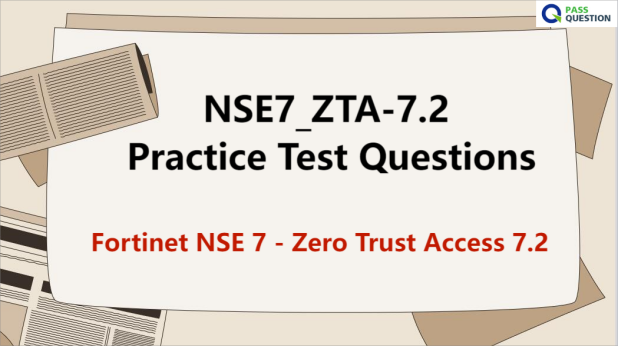NSE7_ZTA-7.2 Practice Test Questions - Fortinet NSE 7 - Zero Trust Access 7.2
To acquire the prestigious FCSS in ZTA certification, you are required to successfully pass the NSE7_ZTA-7.2 Fortinet NSE 7 - Zero Trust Access 7.2 exam. To assist in your preparation, PassQuestion provides the most recent NSE7_ZTA-7.2 Practice Test Questions which have been developed to effectively meet all your certification objectives, ensuring you have a comprehensive understanding of the subject matter. By utilizing these NSE7_ZTA-7.2 Practice Test Questions, you are enhancing your knowledge specifically for the Fortinet NSE7_ZTA-7.2 certification exam. With proper preparation and dedication, you are guaranteed to pass your Fortinet NSE7_ZTA-7.2 exam successfully on your first attempt, paving the way for a successful career.

FCSS in Zero Trust Access (ZTA) Certification
The FCSS in ZTA certification validates your ability to design, administer, monitor, and troubleshoot Fortinet ZTA solutions. This curriculum covers ZTA infrastructures using advanced Fortinet solutions. We recommend this certification for cybersecurity professionals who require the expertise needed to design, manage, support, and analyze advanced Fortinet ZTA solutions. To obtain the FCSS in Zero Trust Access certification, you must pass the Fortinet NSE 7–Zero Trust Access exam. The certification will be active for two years.
Fortinet NSE 7 - Zero Trust Access 7.2 Exam
The Fortinet NSE 7 - Zero Trust Access 7.2 exam is a part of the Fortinet Certified Solution Specialist - Zero Trust Access certification pathway. This certificate is a testament to your capabilities in designing, managing, observing, and resolving issues related to Fortinet's ZTA offerings. The exam assesses your understanding and proficiency with Fortinet's zero trust access (ZTA) and zero trust network access (ZTNA) products. It measures practical knowledge, skills, and the capacity to deploy, manage, and operate Fortinet ZTA solutions utilizing FortiNAC and FortiClient EMS. It's designed for network and security experts who oversee the design, management, operation, and assistance of Fortinet ZTA and ZTNA solutions.
Exam Information
- Exam Name: Fortinet NSE 7 - Zero Trust Access 7.2
- Exam series: NSE7_ZTA-7.2
- Time allowed: 70 minutes
- Exam questions: 30 multiple-choice questions
- Scoring Pass or fail. A score report is available from your Pearson VUE account
- Language: English
- Product version: FortiClient EMS 7.0, FortiNAC 9.4, FortiAuthenticator 6.4, and FortiOS 7.2
Fortinet NSE7_ZTA-7.2 Exam Objectives
Zero trust access (ZTA) methodology and components
- Define the legacy perimeter-based security architecture
- Define ZTA architecture
- Identify the ZTA components
Network access control
- Deploy FortiNAC
- Configure and manage FortiNAC
- Use device onboarding
Zero trust network access (ZTNA) deployment
- Identify the ZTNA components
- Configure ZTNA solution
- Manage access to protected resources
Endpoint compliance
- Configure FortiNAC agents
- Explain endpoint compliance and workflow
- Integrate FortiClient EMS with FortiNAC
- Monitor endpoints
Incident response
- Configure FortiAnalyzer playbooks
- Configure FortiNAC incident response
- Use FortiClient EMS quarantine management
View Online Fortinet NSE 7 - Zero Trust Access 7.2 NSE7_ZTA-7.2 Free Questions
1. Which three statements are true about zero-trust telemetry compliance1? (Choose three.)
A.FortiClient EMS creates dynamic policies using ZTNAtags
B.FortiChent checks the endpoint using the ZTNAtags provided by FortiClient EMS
C.ZTNA tags are configured in FortiClient, based on criteria such as certificates and the logged in domain
D.FortiOS provides network access to the endpoint based on the zero-trust tagging rules
E.FortiClient EMS sends the endpoint information received through FortiClient Telemetry to FortiOS
Answer: A, B, D
2. Which three statements are true about a persistent agent? (Choose three.)
A.Agent is downloaded and run from captive portal
B.Supports advanced custom scans and software inventory.
C.Can apply supplicant configuration to a host
D.Deployed by a login/logout script and is not installed on the endpoint
E.Can be used for automatic registration and authentication
Answer: B, C, E
3. In which FortiNAC configuration stage do you define endpoint compliance?
A.Device onboarding
B.Management configuration
C.Policy configuration
D.Network modeling
Answer: C
4. With the increase in loT devices, which two challenges do enterprises face? (Choose two.)
A.Bandwidth consumption due to added overhead of loT
B.Maintaining a high performance network
C.Unpatched vulnerabilities in loT devices
D.Achieving full network visibility
Answer: C, D
5. Which statement is true about FortiClient EMS in a ZTNA deployment?
A.Uses endpoint information to grant or deny access to the network
B.Provides network and user identity authentication services
C.Generates and installs client certificates on managed endpoints
D.Acts as ZTNA access proxy for managed endpoints
Answer: A
6. An administrator is trying to create a separate web tittering profile for off-fabric and on-fabric clients and push it to managed FortiClient devices
Where can you enable this feature on FortiClient EMS?
A.Endpoint policy
B.ZTNA connection rules
C.System settings
D.On-fabric rule sets
Answer: A
7. What are the three core principles of ZTA? (Choose three.)
A.Verity
B.Be compliant
C.Certify
D.Minimal access
E.Assume breach
Answer: A, D, E
8. With the increase in loT devices, which two challenges do enterprises face? (Choose two.)
A.Bandwidth consumption due to added overhead of loT
B.Maintaining a high performance network
C.Unpatched vulnerabilities in loT devices
D.Achieving full network visibility
Answer: C, D
9. Which method is used to install passive agent on an endpoint?
A.Deployed by using a login/logout script
B.Agent is downloaded from Playstore
C.Agent is downloaded and run from captive portal
D.Installed by user or deployment tools
Answer: D
10. Which statement is true regarding a FortiClient quarantine using FortiAnalyzer playbooks?
A.FortiGate sends a notification to FortiClient EMS to quarantine the endpoint
B.FortiAnalyzer discovers malicious activity in the logs and notifies FortiGate
C.FortiAnalyzer sends an API to FortiClient EMS to quarantine the endpoint
D.FortiClient sends logs to FortiAnalyzer
Answer: C
- TOP 50 Exam Questions
-
Exam
All copyrights reserved 2025 PassQuestion NETWORK CO.,LIMITED. All Rights Reserved.

